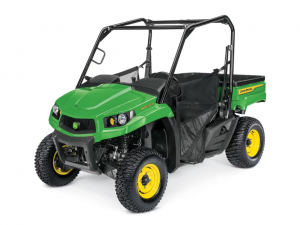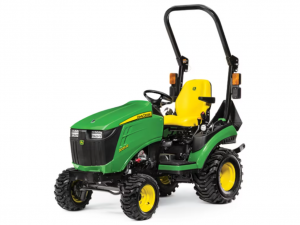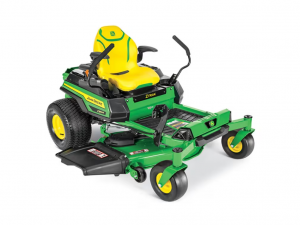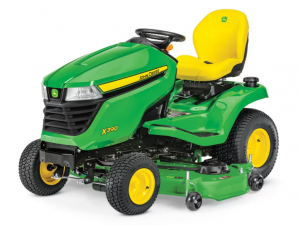7 Lawn Care Tips To Make Your Yard Look Its Best
From watering to cutting to fertilizing, proper lawn care can seem daunting. Luckily, you don’t have to be an expert to make your yard look stunning. All it takes is a little research to know what’s needed to get the job done. With these easy-to-follow tips, you’ll know what to do — and which type of John Deere riding lawn mower you need — to keep your lawn looking green and healthy.
1.) Find the right John Deere riding mower for your needs
Mowing can be a lot easier when you have the right mower for your type of lawn. While John Deere zero-turn mowers are popular for large, flat lawn types, homeowners with less acreage will likely find the lineup of John Deere lawn tractors more suitable. Also, consider equipping your John Deere riding mower with attachments and accessories to make mowing even easier.
2.) What to know before you mow: grass type
Knowing the grass type of your lawn is a crucial factor for determining how to maintain it. Grass types vary by region and climate. Areas with warm climates year-round require a different approach in comparison to those with cooler temperatures. For example, one of the most popular grass types for colder climates, Kentucky bluegrass, should not be cut lower than three inches. In contrast, Buffalo grass — which thrives in warm environments — can be cut as low as one inch. Once you know the grass type of your lawn, you can then research how frequently to mow, the recommended height to cut it, and the required nutrients to keep it healthy.
3.) Mulch or bag: the choice is yours
Content Area 4
After you mow, it’s time to decide what to do with the grass clippings. For a fast, efficient way to clean clippings, consider bagging, which is as simple as it sounds. With bagging, all you do is gather leftover clippings and place them in bags. If you want to take the bagging route, be sure to check out John Deere bagging attachments that you can attach to your mower. However, mulching is also an attractive option as it provides more benefits than the tidy-looking lawn you get from bagging. With mulching, you reuse grass clippings from your recently mowed lawn and bring them back into the soil with nutrients that help keep it healthy. If mulching sounds more your style, take a look at the John Deere MulchControl™ System to simplify the process and see which mowers are compatible with it.
4.) How and when to water
Just as grass types vary, so do the amounts of time needed for proper watering. Too much water could result in waterlogging or flooding, while too little can leave it looking brown and dry. It’s generally recommended to water most grass types about one-to-two times per week. Cool-season grass should receive about 1-to-1.5 inches of water every week. In contrast, grass in warmer regions, as you might expect, typically requires a lesser amount of water (keep in mind that this can vary when you consider the possibility of heatwaves and spells of time with consistently extreme heat).
Whether it’s with pop-up sprinklers, stationary lawn sprinklers, or another type of sprinkler system, water must reach all parts of your lawn. Most systems allow you to schedule the time that you want them to run and how long they spray. For maximum water absorption, run sprinklers in the morning, preferably at dawn.
5.) Feed your grass what it craves: fertilizer
Along with water, grass needs nutrients to help it grow and stay healthy. That’s where fertilizing comes in. Like watering, your approach to fertilizing — how often and which type of fertilizer to use — depends on whether your lawn has cool- or warm-season grass as each has different needs. Most lawns should be fertilized at least one to two times per year, although this can vary as some types of fertilizer provide more nutrients than others. Equally important is knowing when to fertilize. Early spring is typically a good time to fertilize, as this feeds your grass with nutrients that help it grow throughout the season. For cool-season grass, apply fertilizer again in fall to keep it healthy throughout the remainder of autumn and icy winter months that follow. Shortly after each fertilizer application, remember to water your lawn to help grass soak up its nutrients.
6.) Help nutrients reach grass roots with aeration
Aeration is a great way to help your lawn’s grass roots receive more oxygen, sunlight and nutrients. Your yard doesn’t necessarily need to be aerated each year, but there are signs that it may be time for aeration. Season after season of being trodden upon can cause your lawn’s soil to become dense to the point that it prevents needed nutrients from reaching your grass’s roots. Next time you aerate your lawn, plan to fertilize afterward as aeration helps make it easier for the fertilizer’s nutrient-rich components to descend lower to grass roots.
7.) Keep weeds and pests away
You’re not the only one who appreciates a beautiful, lush lawn. Unfortunately, so do insects, animals, and weeds. Unwanted pests like these can damage your property and hinder healthy growth. Besides chewing up plants, moles and voles can dig tunnels, which, along with being an eyesore, can negatively impact your lawn. Consider spreading castor oil throughout your yard to help shoo them away (they don’t like the smell).
Weeds can be just as damaging to your lawn, if not more. Weeds are just as hungry for water and sunlight as your lawn’s grass. They’ll take all they can get and rob your grass of nutrients in the process. Therefore, always have weeding tools on-hand, so you’re ready to remove weeds whenever they emerge. If weeds spread rapidly to the point that they aren’t easy to manage, consider using herbicide. Before you purchase herbicide, find out which types of weeds you’re dealing with, so you can get the appropriate type of herbicide for the job.




